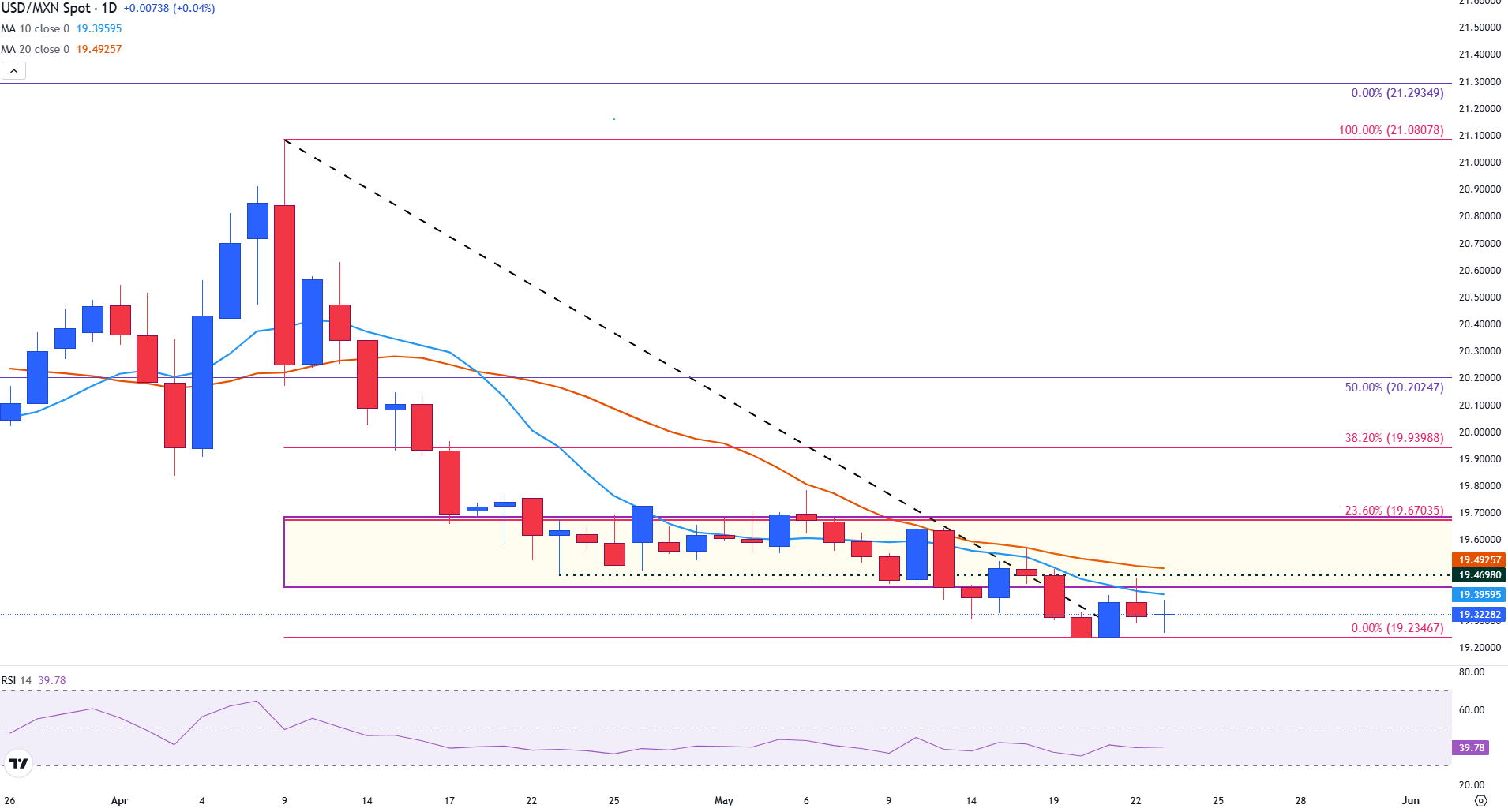- The Mexican Peso remains firm, buoyed by a weaker Greenback after Trump’s tax and spending bill was approved by the US House of Representatives.
- Mexican Trade data and Fed speakers ahead of US Housing data remain key for the USD/MXN in the near term.
- USD/MXN bears remain in control, with the May low proving the next technical hurdle.
The Mexican Peso (MXN) is benefiting from the renewed US Dollar (USD) weakness on Friday, which is driven by concerns over the health of the United States (US) deficit after the US House of Representatives voted in favour of Trump’s administration tax and spending bill.
As investors assess the impact of the bill on the US debt burden, the future growth prospects, and interest-rate expectations, USD/MXN remains below prior psychological support at 19.30, which is providing immediate resistance at the time of writing.
Fed speakers and Mexican Trade data to drive volatility
Mexico’s Trade Balance data released on Friday showed a deficit of $0.088 billion, less than the $0.16 billion forecast by analysts. The report, published by the National Institute of Statistics and Geography of Mexico (INEGI) on a monthly basis, reflects the difference between a country’s exports and its imports. Despite posting a narrower-than-expected trade deficit, it still represents a swing from the $3.442 billion surplus reported in March.
For the United States (US), speakers of the Federal Reserve (Fed) will continue to provide comments about interest rate expectations. Investors will be monitoring the comments closely for signs of any changes in when the Fed may cut interest rates.
At 14:00 GMT, Housing data will be released, reflecting the demand for housing in April, perceived as a leading indicator of spending and demand for credit.
Mexican Peso daily digest: US fiscal concerns linger.
- Fiscal concerns surrounding the passing of Trump’s proposed tax bill have increased. The “Big, Beautiful Bill” is expected to increase the US federal deficit by $3.8 trillion over the 2026-2034 period, according to the US Congressional Budget Office.
- The recent rating downgrade by Moody’s agency, combined with President Trump’s tax bill, has weighed on the US Dollar. A rating downgrade reflects reduced faith in the US to repay its debt.
- Fed speakers on Friday include St. Louis Fed President Alberto Musalem, Kansas City Fed President Jeff Schmid, and Governor Lisa Cook, who are all voting members of the Fed.
- The CME FedWatch tool indicates a 94.7% probability that interest rates will remain in the current range of 4.25%-4.50% in June, with analysts not expecting any Fed rate cut until September.
- With the Bank of Mexico (Banxico) cutting interest rates by 0.50% at its May meeting, the divergence in interest rate differentials between both countries should support demand for the USD.
- However, on Thursday, Mexico’s 1st half-month inflation data came in higher than expected at 0.09%, reflective of an increase in price pressures.
- Thursday’s data also showed that Mexico’s Growth Domestic Product (GDP) grew by 0.2% on quarter and by 0.8% on year, in line with market expectations.
- With the economy seen as resilient despite increased tariffs from the US, it could reduce pressure on Banxico to continue cutting rates in the near term.
Mexican Peso technical analysis: USD/MXN trades near 19.30
USD/MXN remains near 19.30, trading below the 10-day and 20-day Simple Moving Average (SMA) at the respective levels of 19.39 and 19.49. With a break above 19.30 potentially bringing these levels into play, a move below would suggest that sellers are in control of the trend.
The Relative Strength (RSI) indicator is at 37.77, showing downside momentum is firm.
Should the downtrend hold, a retest of the May low of 19.23 would bring the October low of 19.11 into sight, with the next layer of support at the next psychological level of 19.00.
USD/MXN daily chart

Mexican Peso FAQs
The Mexican Peso (MXN) is the most traded currency among its Latin American peers. Its value is broadly determined by the performance of the Mexican economy, the country’s central bank’s policy, the amount of foreign investment in the country and even the levels of remittances sent by Mexicans who live abroad, particularly in the United States. Geopolitical trends can also move MXN: for example, the process of nearshoring – or the decision by some firms to relocate manufacturing capacity and supply chains closer to their home countries – is also seen as a catalyst for the Mexican currency as the country is considered a key manufacturing hub in the American continent. Another catalyst for MXN is Oil prices as Mexico is a key exporter of the commodity.
The main objective of Mexico’s central bank, also known as Banxico, is to maintain inflation at low and stable levels (at or close to its target of 3%, the midpoint in a tolerance band of between 2% and 4%). To this end, the bank sets an appropriate level of interest rates. When inflation is too high, Banxico will attempt to tame it by raising interest rates, making it more expensive for households and businesses to borrow money, thus cooling demand and the overall economy. Higher interest rates are generally positive for the Mexican Peso (MXN) as they lead to higher yields, making the country a more attractive place for investors. On the contrary, lower interest rates tend to weaken MXN.
Macroeconomic data releases are key to assess the state of the economy and can have an impact on the Mexican Peso (MXN) valuation. A strong Mexican economy, based on high economic growth, low unemployment and high confidence is good for MXN. Not only does it attract more foreign investment but it may encourage the Bank of Mexico (Banxico) to increase interest rates, particularly if this strength comes together with elevated inflation. However, if economic data is weak, MXN is likely to depreciate.
As an emerging-market currency, the Mexican Peso (MXN) tends to strive during risk-on periods, or when investors perceive that broader market risks are low and thus are eager to engage with investments that carry a higher risk. Conversely, MXN tends to weaken at times of market turbulence or economic uncertainty as investors tend to sell higher-risk assets and flee to the more-stable safe havens.

